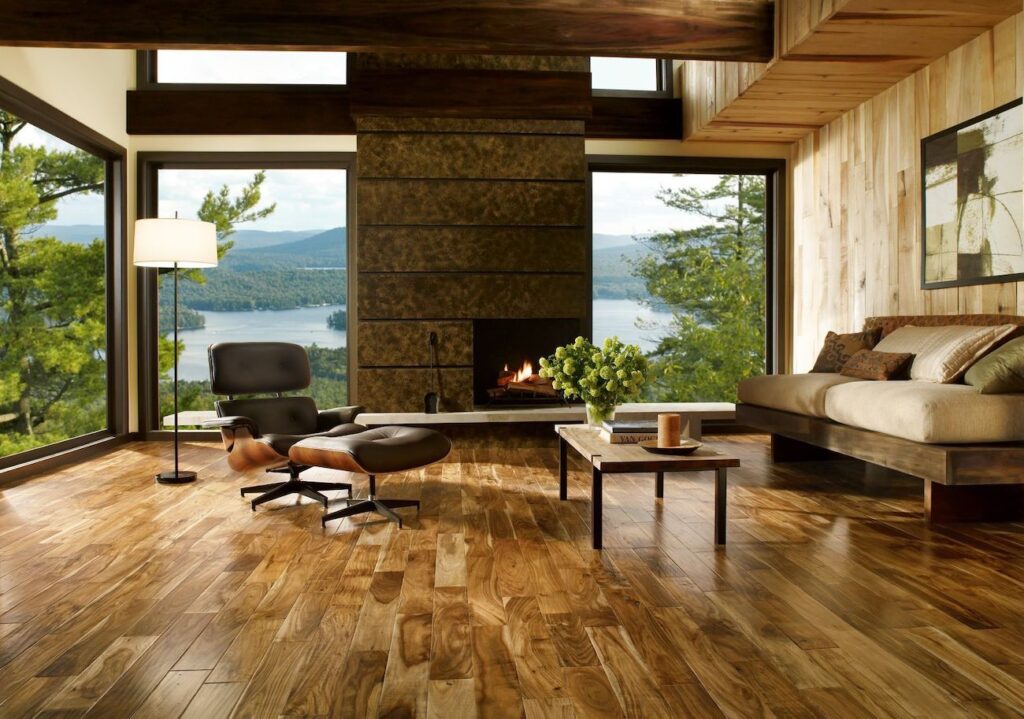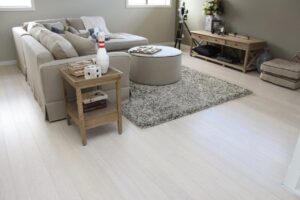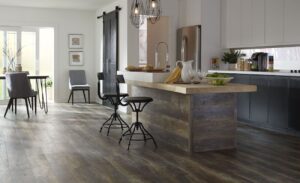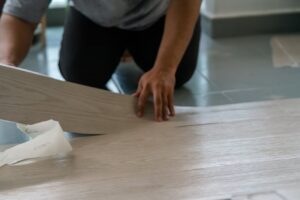Acacia Hardwood Flooring Review is the guide you didn’t know you needed but absolutely do.
We start by offering a brief overview of acacia as a distinguished hardwood option for flooring. Acacia’s significance in the flooring industry is unparalleled due to its unique characteristics, which we will delve into throughout this article.
The objective of this article is to provide you with comprehensive information about acacia hardwood flooring, from its durability and aesthetic appeal to cost considerations. Keep reading to make an informed choice about this flooring material.

What Makes Acacia Flooring a Worthy Choice
If you’re on the fence about which flooring material to opt for, allow us to shed light on why acacia makes a compelling case.
We will discuss various facets, including its affordability, unique aesthetic characteristics, environmental sustainability, and long-lasting durability.
Affordability Factor
One of the standout aspects of acacia hardwood flooring is its cost-effectiveness. While offering similar durability to other hardwood options, acacia often comes at a fraction of the price.
Note: While it is generally affordable, the final cost can vary depending on the grade and finish you select.
Rustic Appeal and Unique Aesthetic
Acacia flooring stands out for its rich color variations and intricate grain patterns. This creates a rustic yet sophisticated appeal that blends well with a wide range of interior designs.
- Color Variations: Ranging from light amber to dark mahogany.
- Grain Patterns: Often swirly and highly textured.
Environmental Sustainability
Another notable advantage is acacia’s sustainable nature. It grows relatively quickly compared to other hardwoods, making it a more renewable resource.
This makes acacia an eco-friendly choice for those concerned with minimizing their environmental impact.
Longevity and Durability
When it comes to holding up against wear and tear, acacia is exceptional.
Known for its inherent strength and resilience against everyday challenges like stains and spills, this wood species offers a longevity that many homeowners find appealing.
- Stain Resistance: Holds up well against liquid spills.
- Scratch Resistance: Suitable for homes with pets.
By covering these key aspects, we hope to make your decision-making process regarding acacia hardwood flooring a more informed one.
Characteristics of Acacia Wood
As we evaluate acacia hardwood flooring, understanding the intrinsic qualities of acacia wood itself becomes crucial.
In this section, we delve into the origin and habitat of acacia, how it stacks up against other hardwoods in terms of strength, its eco-friendly attributes, and its unique aesthetic qualities.
Origin and Habitat
Acacia primarily originates from Australia and Africa but is also found in Asia and the Americas. This adaptability to diverse climates contributes to its wide availability and consequent affordability.
Strength Comparison with Other Hardwoods
When it comes to strength, acacia wood holds its own. With a Janka hardness rating ranging from 1,100 to over 3,000 lbf, it surpasses many other hardwoods.
To provide a better perspective, let’s look at a comparison table:
| Wood Type | Janka Hardness Rating (lbf) |
|---|---|
| Acacia | 1,100 – 3,000+ |
| Oak | 1,220 |
| Maple | 1,450 |
| Teak | 1,155 |
Note: Higher Janka rating indicates greater hardness and durability.
Environmental Friendliness
From an eco-conscious standpoint, acacia wood is a responsible choice. It has a rapid growth rate, thus ensuring a more sustainable yield. This contrasts favorably with many hardwoods that take longer to mature, making acacia a more renewable resource.
Unique Aesthetic Qualities
Acacia wood is a visual feast, offering a tapestry of vibrant hues and complex grain patterns. This imbues any flooring made from acacia with a sense of character and sophistication.
- Color Spectrum: From light tan to dark brown.
- Grain Complexity: A medley of straight and wavy lines.
Through these characteristics, acacia wood offers not just a functional but also a visually appealing flooring option.
Read Also: Best Laminate Flooring Brands Worth To Buy
Understanding the Different Varieties of Acacia
The diversity among acacia species is a significant factor when considering flooring options.
This section will focus on various acacia species and their geographical presence, commonly used aliases, distinct grain patterns, and resistance to environmental elements.
Acacia Species and Their Geographical Presence
Acacia boasts over 1,300 species, predominantly originating from Australia, Africa, and the Americas.
However, only a few species like Acacia melanoxylon and Acacia dealbata are commonly used for flooring.
| Species | Geographical Presence |
|---|---|
| Acacia melanoxylon | Australia |
| Acacia dealbata | Australia, Africa |
Other Common Names
Acacia wood often goes by several aliases, depending on the region.
For example, Acacia melanoxylon is also known as Blackwood, while Acacia dealbata is often referred to as Silver Wattle.
- Blackwood: Acacia melanoxylon
- Silver Wattle: Acacia dealbata
Grain Patterns and Distinctive Features
Acacia wood is known for its unique grain patterns, which range from straight to a complex interplay of wavy lines.
These patterns often include:
- Whorls
- Spirals
- Straight Lines
Note: The distinctive grain patterns contribute to the wood’s aesthetic appeal, making each flooring piece unique.
Resistance to Elements
Acacia wood is highly resistant to environmental stressors such as moisture and pests, thanks in part to its natural oils. This makes it suitable for use in a variety of settings, from high-humidity areas to places with fluctuating temperatures.
This rich variety in acacia species and their respective features allows for a wide range of options, each with its own set of benefits and aesthetic appeal.

Types of Acacia Flooring Options
Selecting the right flooring type requires attention to various attributes like composition, durability, and appearance.
This section delves into the specific features of different types of acacia flooring: solid, engineered, and laminate.
Solid Acacia Flooring Specifications

Solid acacia flooring consists of single-piece planks, typically 3/4 inches thick. Its striking features include:
- Natural grain patterns
- High durability
- Suitable for sanding and refinishing
| Thickness | Durability | Refinishing Capability |
|---|---|---|
| 3/4 inches | High | Yes |
Note: Solid acacia flooring is best suited for areas not prone to high moisture levels.
Engineered Acacia Flooring Features
Engineered flooring comprises a top layer of acacia wood and several layers of plywood.
Key attributes include:
- Stability in fluctuating temperatures
- Suitable for below-ground installations
- Lower cost compared to solid acacia
| Top Layer | Stability | Cost-effectiveness |
|---|---|---|
| Acacia | High | Moderate |
Laminate Acacia Flooring Characteristics
Laminate acacia flooring offers a synthetic option, replicating acacia’s appearance through a photographic layer.
Features to consider:
- Easy to install
- Low maintenance
- Not suitable for refinishing
| Installation | Maintenance | Refinishing Capability |
|---|---|---|
| Easy | Low | No |
Selecting between these types involves multiple considerations such as location, climate, and budget.
Each comes with its own set of advantages and factors to ponder, offering potential buyers a versatile set of options to fit various needs.
A Comprehensive Guide to Acacia Flooring Brands and Pricing
Making an informed decision about acacia flooring also involves knowing which brands offer quality products at various price points.
This section reviews prominent brands for solid, engineered, and laminate acacia flooring, helping you make a more knowledgeable choice.
Leading Brands for Solid Acacia Flooring
Several brands specialize in delivering top-notch solid acacia flooring:
- Armstrong Flooring: Known for their durability and quality.
- Lumber Liquidators: Offers a wide variety of styles.
| Brand | Average Price per sq ft | Notable Features |
|---|---|---|
| Armstrong Flooring | $6-$8 | Durability |
| Lumber Liquidators | $5-$7 | Variety of styles |
Note: Prices can vary based on location and availability.
Top Engineered Acacia Flooring Brands
For engineered acacia flooring, these brands are reputable:
- Mohawk Flooring: Renowned for its stability and durability.
- Bruce Flooring: Offers a range of colors and finishes.
| Brand | Average Price per sq ft | Notable Features |
|---|---|---|
| Mohawk Flooring | $4-$6 | Stability |
| Bruce Flooring | $3-$5 | Color variety |
Economical Options for Laminate Acacia Flooring
If budget is a concern, consider these brands for laminate options:
- Pergo: Known for cost-effectiveness and easy installation.
- TrafficMaster: Offers decent quality at an affordable price.
| Brand | Average Price per sq ft | Notable Features |
|---|---|---|
| Pergo | $2-$3 | Cost-effectiveness |
| TrafficMaster | $1-$2 | Affordability |
From premium to budget-friendly, these brands offer a range of products to meet different needs, ensuring you don’t have to compromise on quality while adhering to your financial constraints.

Measuring the Durability of Acacia Wood
Assessing the longevity of acacia flooring requires a multifaceted approach. From scientific ratings to everyday wear and tear, this section delves into the durability factors you should consider before making your purchase decision.
Janka Hardness Rating
Acacia wood boasts a Janka hardness rating of approximately 1750. To put this in perspective:
| Wood Type | Janka Rating |
|---|---|
| Oak | 1290 |
| Maple | 1450 |
| Acacia | 1750 |
A higher Janka rating means greater resistance to dents and scratches, making acacia an excellent choice for high-traffic areas.
Note: Janka ratings can slightly differ depending on the specific species of acacia wood.
Resistance to Damage
Besides its commendable Janka rating, acacia is also resistant to:
- Moisture damage
- Insect infestation
- Fading due to UV exposure
This ensures that your acacia flooring remains in good condition for years, even when subjected to environmental stressors.
Long-Term Maintenance Aspects
While acacia is quite hardy, regular maintenance ensures its longevity:
- Regular Cleaning: Simple sweeping or vacuuming removes dust and debris.
- Spot Cleaning: Tackle spills immediately to prevent staining.
- Re-finishing: Every 10 to 12 years, a re-finishing job may be needed to restore the floor’s original luster.
Understanding these durability factors allows for a well-rounded view of what to expect from your acacia flooring in terms of its lifespan. By considering these aspects, you can better gauge whether acacia flooring aligns with your needs and lifestyle.

Advantages of Choosing Acacia Flooring
Selecting the right flooring material is a significant decision, and acacia flooring comes with a host of advantages. From aesthetics to environmental concerns, let’s evaluate why acacia might be the flooring choice that meets your requirements.
Aesthetic Diversity and Unique Coloring
Acacia flooring stands out for its rich hues and intricate grain patterns. You’ll find shades ranging from light amber to dark mahogany, often within the same plank. This adds a layer of sophistication to any space. Whether you are going for a classic or contemporary interior design, acacia’s diverse aesthetic features offer something for everyone.
Easy Maintenance Requirements
Contrary to some other hardwoods, acacia is relatively straightforward to maintain. Here are some essential steps:
- Dry Mopping: Keeps the floor free from dust and debris.
- Spot Cleaning: Use a damp cloth for accidental spills.
- Polishing: A light polish every 6–12 months retains the floor’s shine.
Note: Always use cleaning products that are specifically designed for hardwood floors.
Sustainability and Eco-Friendly Characteristics
Acacia trees grow relatively fast, and their wood is sourced responsibly. Most acacia flooring options come with certifications like FSC (Forest Stewardship Council), assuring you that your choice is contributing to sustainable forestry practices.
Wide Range of Installation Methods
Acacia flooring is compatible with a variety of installation methods:
- Nail Down
- Glue Down
- Floating Installation
This versatility allows acacia to be an option for different subfloors and rooms, including basements.
In essence, acacia flooring’s various advantages make it a compelling option for homeowners looking for an ideal balance between aesthetics, ease of maintenance, and environmental responsibility.
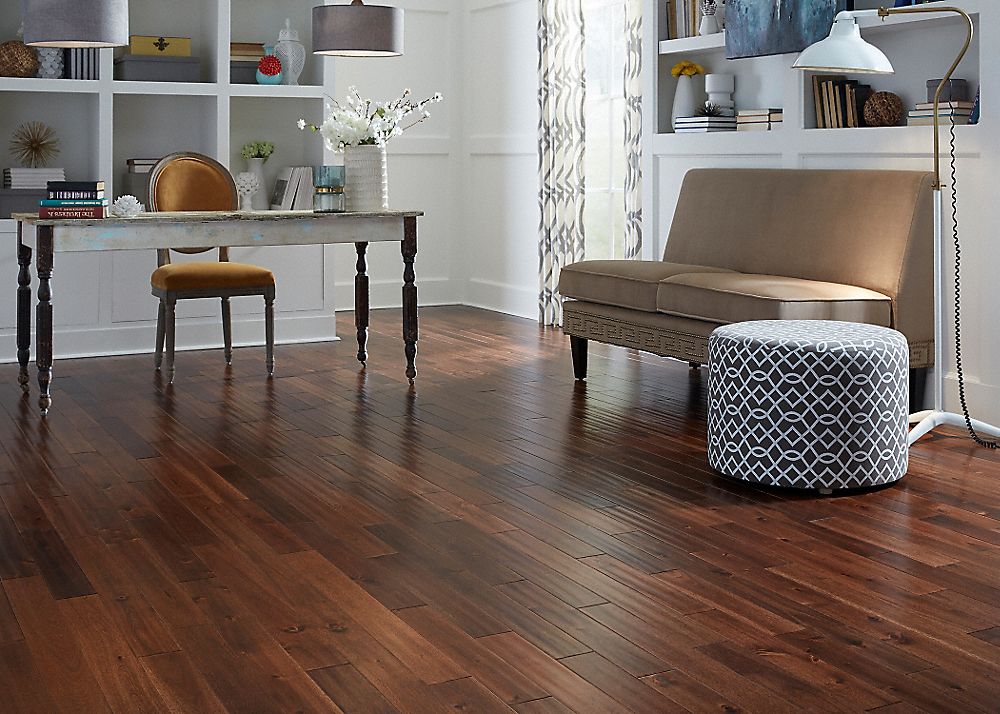
Read Also: Laminate Flooring Reviews, Ideas, Pros & Cons For Your Home
Challenges Associated with Acacia Flooring
While acacia flooring offers several advantages, it’s important to be aware of some challenges that might influence your purchasing decision. This section sheds light on aesthetic considerations, plank length, cost factors, and availability issues.
Aesthetic Limitations and Presence of Knots
Acacia’s unique grain patterns and rich hues are not for everyone. The pronounced grains and occasional knots may be perceived as imperfections or distractions, especially in minimalist or ultra-modern settings.
Note: If you’re looking for a more uniform look, acacia flooring might not be your first choice.
Short Plank Lengths
One often-noted feature of acacia is the typically shorter plank lengths, which range from 12 to 48 inches. While this can add visual interest, it may also require more time and effort during the installation process.
Cost Comparison with Other Hardwoods
Acacia is generally priced in the mid-to-high range when compared to other hardwood options.
For your convenience, below is a cost comparison table:
| Hardwood Type | Average Cost per Sq. Ft. |
|---|---|
| Acacia | $3.50 – $8.00 |
| Oak | $3.00 – $6.00 |
| Maple | $4.00 – $8.00 |
| Teak | $8.00 – $13.00 |
Availability and Sourcing Concerns
Acacia flooring is not as readily available as other hardwoods like oak or maple. While it can be sourced responsibly, you may face challenges in finding a variety of styles or shades.
Also, if sustainability is a primary concern, make sure to check for certifications, as not all acacia products are certified.
Being aware of these challenges will allow you to make a more informed decision when considering acacia as your flooring material of choice.
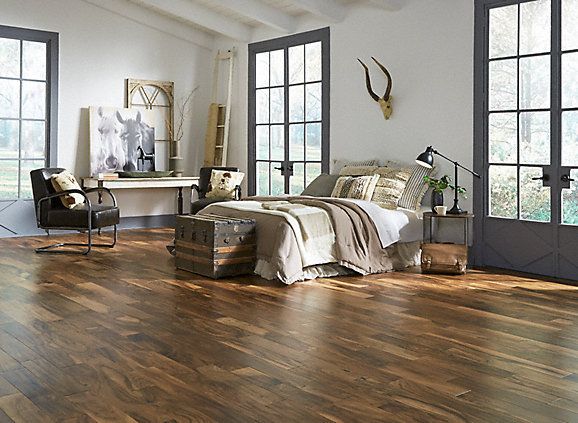
Key Factors to Consider Before Making a Purchase
Selecting the right flooring is an important decision that involves various considerations.
This section will guide you through critical aspects such as matching with home aesthetics, maintenance needs, durability, and suitability for different home areas.
Matching with Home Style and Aesthetics
Before choosing acacia flooring, ask yourself how it would complement your existing home decor. Acacia offers rich textures and hues that might be a focal point in any room but could also clash with certain interior design styles.
Note: Consider ordering samples to see how the flooring meshes with your home environment.
Maintenance Requirements
Every flooring option requires some level of upkeep. Acacia, for example, needs periodic sealing to retain its luster and durability.
A general maintenance checklist for acacia flooring might include:
- Regular sweeping or vacuuming
- Use of specialized hardwood cleaners
- Avoiding excessive water exposure
Long-Term Durability
While acacia has a strong Janka hardness rating, indicating good resistance to wear and tear, it’s crucial to consider how it will hold up over the years. Factors such as foot traffic, pets, and furniture should be taken into account.
Suitability for Different Home Zones
Acacia flooring works well in both low-moisture and high-moisture environments. However, it may not be the most suitable option for areas that are consistently wet, like bathrooms. Here’s a quick guide on where to install acacia flooring:
| Room Type | Suitability |
|---|---|
| Living Room | Highly Suitable |
| Bedroom | Highly Suitable |
| Kitchen | Moderately Suitable |
| Bathroom | Less Suitable |
By understanding these key factors, you can make a more informed decision to ensure that your investment in acacia flooring is a sound one.
Evaluating Acacia as a Flooring Material
Selecting a flooring material goes beyond mere aesthetics; it is about a blend of durability, cost, health benefits, and adaptability. This section provides a comprehensive review of these various aspects to aid in your acacia flooring decision.
Overall Durability and Longevity
Acacia flooring is revered for its strength and ability to withstand wear and tear. With a high Janka hardness rating, acacia remains a viable choice for high-traffic areas in a home. When adequately maintained, this flooring can last decades.
Note: Factor in lifestyle elements such as pets and foot traffic when evaluating durability.
Economical Factors and Availability
Cost often plays a pivotal role in flooring decisions. Acacia flooring can be more expensive than other hardwood options, but it compensates with its longevity and low maintenance requirements. While acacia is readily available, variations in grain patterns and color can affect pricing.
Health and Environmental Benefits
One of the often-overlooked advantages of acacia flooring is its health benefits. Acacia wood does not harbor allergens to the extent that carpets can. Moreover, it is sustainably sourced, making it an eco-conscious choice.
Comfort and Versatility in Applications
Comfort is another aspect where acacia flooring shines. Its natural insulating properties make it warm underfoot, a comforting feature during colder months. Versatility in application is also commendable; acacia is well-suited for both traditional and contemporary home styles.
Here’s a snapshot of acacia’s versatility:
| Application | Suitability |
|---|---|
| Traditional Homes | Highly Suitable |
| Contemporary Homes | Highly Suitable |
| Commercial Spaces | Moderately Suitable |
By carefully evaluating these different facets, you can arrive at a decision that offers both functional and aesthetic satisfaction.
FAQs
Is acacia a good hardwood floor?
Acacia is highly regarded for its robustness, making it an excellent choice for hardwood flooring. Its unique grain patterns and vibrant colors add a luxurious touch. Moreover, it has a high Janka hardness rating, which indicates resistance to wear and tear, particularly in high-traffic areas.
Can acacia wood get wet?
While acacia wood has some water-resistant properties, prolonged exposure to moisture can cause warping or swelling. It is advisable to immediately wipe any liquid spills and to avoid installing it in areas prone to moisture like bathrooms.
What are the benefits of acacia wood?
Acacia wood boasts multiple benefits such as durability, water-resistance, and natural aesthetic appeal. Additionally, it is eco-friendly, often harvested from sustainable sources. Its allergen-resistant properties make it a healthy flooring option.
Is acacia wood long-lasting?
Is acacia soft or hardwood?
Acacia is classified as a hardwood due to its durability and high Janka hardness rating. These characteristics make it suitable for flooring, furniture, and other applications where strength is required.
Does acacia wood rot easily?
Acacia wood has natural oils that offer some level of rot resistance. However, it’s crucial to maintain it properly to extend its life and maintain its resistance to rotting, particularly when used outdoors.
Is acacia hardwood heavy?
Acacia wood has a moderate density, making it neither extremely heavy nor excessively light. This moderate weight contributes to its suitability for a wide range of applications, from flooring to furniture.
Which is better teak or acacia wood?
Both teak and acacia offer unique advantages. Teak is generally more expensive and is often used for high-end outdoor furniture due to its exceptional weather resistance. Acacia, while less expensive, offers impressive durability and a more diverse range of color patterns.
Why is acacia wood so popular?
Acacia wood has gained recognition for its aesthetic diversity, robustness, and eco-friendliness. Its unique grain patterns and colors add an upscale touch to interiors, making it a popular choice for flooring and furniture.
Is acacia wood prone to pests?
Acacia wood is relatively resistant to pests due to its natural oils. However, like all woods, it is advisable to take standard preventive measures to ensure that it remains free from termites and other wood-boring insects.
Conclusion
Acacia hardwood flooring presents a compelling mix of strengths and weaknesses. While it impresses with its aesthetic diversity and durability, it also poses challenges such as cost and short plank lengths.
For those seeking a balance between elegance and resilience, acacia is an apt choice, provided that adequate attention is given to its maintenance and initial costs.
Moving ahead, trends indicate a rising demand for sustainable and allergen-resistant flooring options, which positions acacia as a flooring material of increasing significance.
